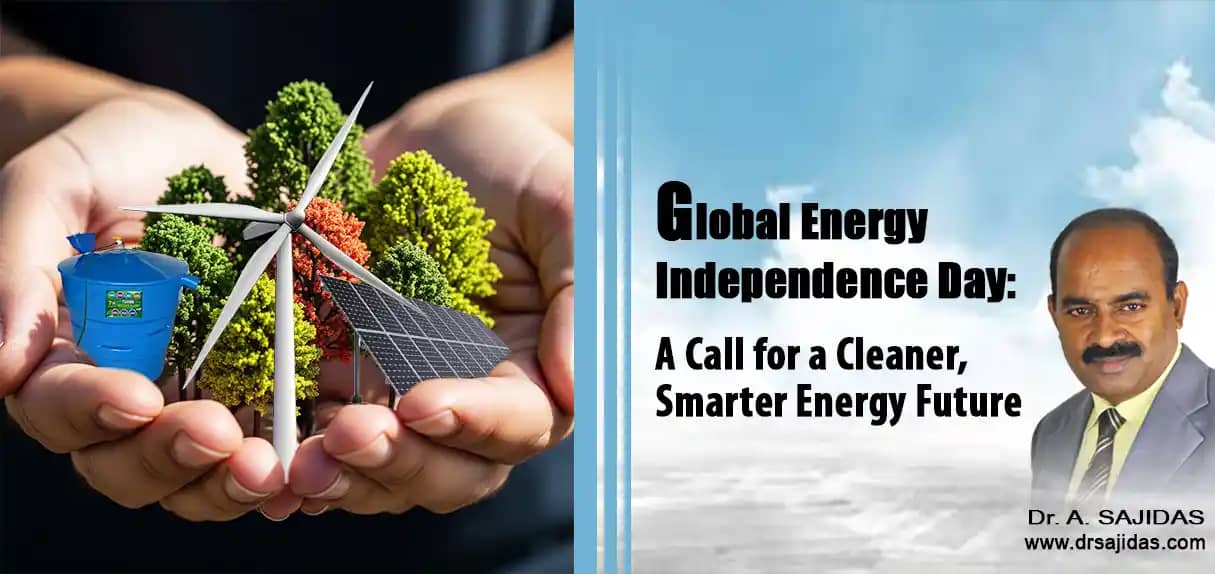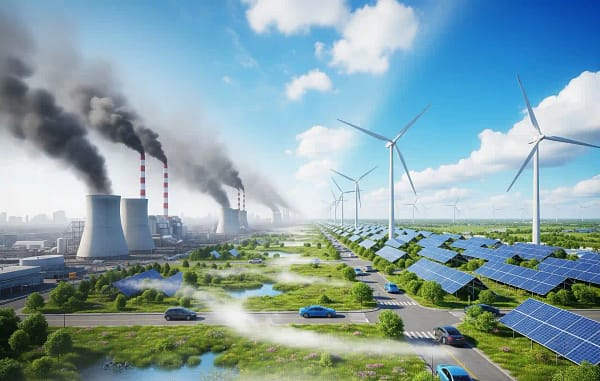
Global Energy Independence Day: A Call for a Cleaner, Smarter Energy Future
Every year on July 10, the world quietly celebrates a day that deserves far more attention: Global Energy Independence Day. It’s not just a symbolic date—it’s a rallying cry for a future where our energy systems are clean, decentralized, and resilient. As the climate crisis intensifies and fossil fuel markets remain volatile, the need to rethink how we power our lives has never been more urgent.
This day, observed on the birthday of the legendary inventor Nikola Tesla, honors his revolutionary contributions to electricity and serves as a reminder of the transformative power of innovation. But more than a tribute to the past, Global Energy Independence Day is a vision for the future—one where communities, countries, and individuals are no longer held hostage by polluting, centralized energy systems.
Let’s explore why this day matters, what it represents, and how we can all be part of the solution.
What Is Global Energy Independence Day?
Global Energy Independence Day is observed annually on July 10 to promote the transition from fossil fuels to clean, renewable energy sources such as solar, wind, hydro, and geothermal. It emphasizes the importance of energy autonomy, climate action, and technological innovation in building a sustainable future.
The day was first promoted in the early 2010s, gaining traction among environmental advocates, educators, and clean energy pioneers. It was inspired by the growing realization that fossil fuel dependence is not only environmentally destructive but also economically and geopolitically risky.
The choice of July 10 is no coincidence—it’s the birthday of Nikola Tesla, the Serbian-American inventor whose work with alternating current (AC) electricity laid the foundation for modern power systems. Tesla’s legacy reminds us that bold ideas and scientific breakthroughs can reshape the world.

Why Energy Independence Matters
Energy independence isn’t just about producing electricity locally—it’s about empowering people and protecting the planet. Here’s why it’s crucial:

Energy independence isn’t just about producing electricity locally—it’s about empowering people and protecting the planet. Here’s why it’s crucial:
1. Climate Change Mitigation
Burning fossil fuels is the largest source of greenhouse gas emissions globally. Transitioning to renewables is essential to limit global warming to 1.5°C and avoid catastrophic climate impacts.
2. Energy Security
Countries that rely heavily on imported oil, gas, or coal are vulnerable to price shocks, supply disruptions, and geopolitical conflicts. Local renewable energy reduces these risks and enhances national resilience.
3. Economic Stability
Renewables are becoming the cheapest source of electricity in many parts of the world. Investing in clean energy creates jobs, reduces energy bills, and stimulates local economies.
4. Environmental Justice
Fossil fuel extraction and combustion disproportionately harm marginalized communities. Clean energy offers a path to more equitable development and healthier living conditions.
5. Technological Innovation
Energy independence drives innovation in storage, smart grids, and efficiency. It encourages decentralized systems that are more adaptable and less prone to large-scale failures.
The Global Picture: Where Do We Stand?
Despite growing awareness, the world remains heavily dependent on fossil fuels. As of 2024:
➣ Fossil fuels still account for over 75% of global energy consumption.
➣ Renewable energy sources make up around 30% of global electricity generation, with hydropower, wind, and solar leading the way.
➣ Many countries have set net-zero targets, but implementation remains uneven and often delayed.
The Global Picture: Where Do We Stand?
Despite growing awareness, the world remains heavily dependent on fossil fuels. As of 2024:
➣ Fossil fuels still account for over 75% of global energy consumption.
➣ Renewable energy sources make up around 30% of global electricity generation, with hydropower, wind, and solar leading the way.
➣ Many countries have set net-zero targets, but implementation remains uneven and often delayed.
However, there are reasons for optimism:
➣ The cost of solar and wind energy has dropped by over 80% in the past decade.
➣ Battery storage technologies are improving rapidly, making renewables more reliable.
➣ Countries like Denmark, Costa Rica, and Iceland are proving that near-total renewable energy systems are possible.
The momentum is building—but we need to accelerate.
How Can We Achieve Energy Independence?
Achieving energy independence requires a multi-pronged approach that combines technology, policy, finance, and public engagement. Here are some key strategies:
1. Scale Up Renewable Energy
Governments and businesses must invest in large-scale solar farms, wind parks, and hydroelectric projects. At the same time, rooftop solar and community energy systems should be incentivized to democratize access.
2. Modernize the Grid
Smart grids, microgrids, and energy storage systems are essential to manage variable renewable energy and ensure reliability. Digital technologies can optimize supply and demand in real time.
3. Electrify Everything
From transport to heating, electrification is key to decarbonization. Electric vehicles, heat pumps, and induction stoves reduce fossil fuel use and integrate well with renewable electricity.
4. Improve Energy Efficiency
The cleanest energy is the energy we don’t use. Upgrading buildings, appliances, and industrial processes can drastically cut energy demand.
5. Reform Policy and Finance
Subsidies for fossil fuels must be phased out, and carbon pricing should reflect the true cost of emissions. Green bonds, climate funds, and public-private partnerships can unlock investment in clean energy.
6. Educate and Empower
Public awareness is crucial. Schools, media, and civil society must promote energy literacy and encourage behavioral change. People need to see themselves not just as consumers, but as producers and stewards of energy.
Tesla’s Legacy: Innovation for the Common Good
Nikola Tesla was more than a brilliant inventor—he was a visionary who believed in using science to uplift humanity. His dream of wireless energy transmission and free electricity for all may have been ahead of its time, but his spirit lives on in today’s clean energy revolution.
Tesla’s work reminds us that technological progress must serve the public good, not just private profit. As we build the energy systems of tomorrow, we must ensure they are inclusive, transparent, and equitable.
How to Celebrate Global Energy Independence Day
Whether you’re an individual, educator, policymaker, or business leader, there are many ways to mark this important day:
For Individuals:
➣ Install solar panels or switch to a green energy provider.
➣ Reduce energy use by upgrading to efficient appliances or using public transport.
➣ Share information about clean energy on social media using #EnergyIndependenceDay.
For Educators:
➣ Organize workshops or webinars on renewable energy and climate change.
➣ Highlight Tesla’s contributions in science and history classes.
➣ Encourage students to design energy-saving projects or models.
For Organizations:
➣ Conduct an energy audit and set sustainability goals.
➣ Host a clean energy fair or partner with local renewable energy providers.
➣ Advocate for supportive policies at the local or national level.
Looking Ahead: A Just and Renewable Future
Global Energy Independence Day is more than a celebration—it’s a challenge. It asks us to imagine a world where energy is not a source of pollution or conflict, but a foundation for peace, prosperity, and planetary health.
This vision aligns closely with the United Nations Sustainable Development Goals (SDGs), particularly:
SDG 7: Affordable and Clean Energy
SDG 13: Climate Action
SDG 9: Industry, Innovation, and Infrastructure
SDG 11: Sustainable Cities and Communities
By working together—across sectors, borders, and generations—we can make this vision a reality.
As we face the twin crises of climate change and energy insecurity, Global Energy Independence Day offers a moment to pause, reflect, and recommit. It reminds us that the path to a better world is not paved with oil and coal, but with sunlight, wind, and human ingenuity.
Let’s honor Tesla’s legacy not just with words, but with action. Let’s build a future where energy is clean, communities are empowered, and the planet thrives.
Because true independence isn’t just about where our energy comes from—it’s about who it serves, and what kind of world it helps create.
